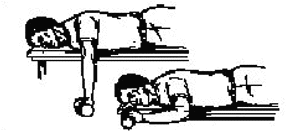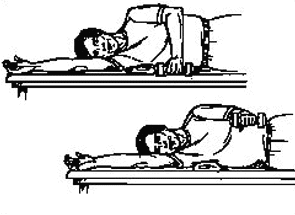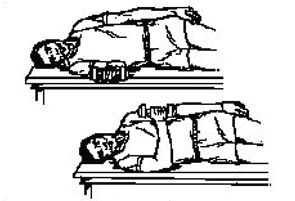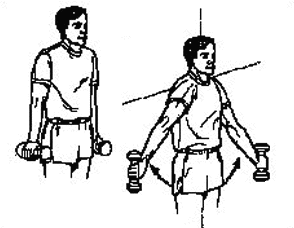
Am Fam Physician. 1998;57(4):680-683
See related article on rotator cuff tears.
Remember that the exercises described on the next two pages, which help strengthen the muscles of your shoulder (especially the rotator cuff), should not cause you pain. If the exercise hurts, use a smaller weight and stop exercising when the pain begins.
Perform each exercise slowly: lift your arm to a slow count of three and lower your arm to a slow count of six.
Look at the pictures with each exercise so you can follow the right position. Warm up before adding weights: stretch your arms and shoulders and do pendulum exercises (bend from the waist, arms hanging down; keeping arm and shoulder muscles relaxed, move arms slowly back and forth).
Keep repeating each exercise until your arm is tired. Use a light enough weight that you don't get tired until you've done the exercise about 20 to 30 times. Increase the weight a little each week (but never so much that the weight causes pain): start with 2 ounces the first week, move up to 4 ounces the second week, 8 ounces the next week, and so on.
If you do all four exercises three to five times a week, your rotator cuff muscles will become stronger and you'll regain normal strength in your shoulder. Each time you finish doing all four exercises, put an ice pack on your shoulder for 20 minutes. It's best to use a plastic bag with ice cubes in it, or a bag of frozen peas, not gel packs.
Exercise 1
Start by lying on your stomach on a table or a bed. Put your left arm out at shoulder level with your elbow bent to 90 degrees and your hand down. Keep your elbow bent and slowly raise your left hand. Stop when your hand is level with your shoulder. Lower the hand slowly. Repeat the exercise until your arm is tired. Then repeat the whole exercise again with your right arm.

Exercise 2
Lie on your right side with a rolled-up towel under your right armpit. Stretch your right arm above your head. Keep your left arm at your side with your elbow bent to 90 degrees and the forearm resting against your chest, palm down. Roll your left shoulder out, raising the left forearm until it's level with your shoulder. (Hint: this is like the backhand swing in tennis.) Lower the arm slowly. Repeat the exercise until your arm is tired. Then repeat the whole exercise again with your right arm.

Exercise 3
Lie on your right side. Keep your left arm along the upper side of your body. Bend your right elbow to 90 degrees. Keep the right forearm resting on the table. Now roll your right shoulder in, raising your right forearm up to your chest. (Hint: this is like the forehand swing in tennis.) Lower the forearm slowly. Repeat the exercise until your arm is tired. Then repeat the whole exercise again with your other arm.

Exercise 4
In a standing position, start with your right arm halfway between the front and the side of your body, thumb down. Raise your right arm until almost level (about a 45 degree angle). (Hint: this is like emptying a can.) Don't lift beyond the point of pain. Slowly lower your arm. Repeat the exercise until your arm is tired. Then repeat the whole exercise again with your other arm.
